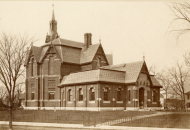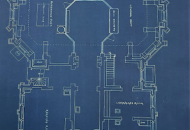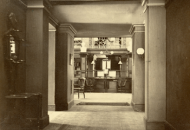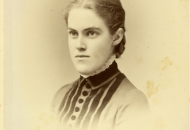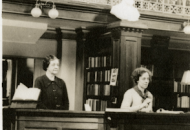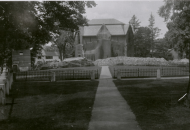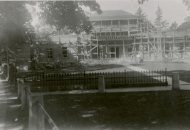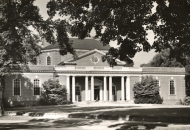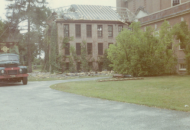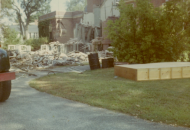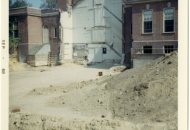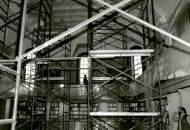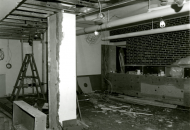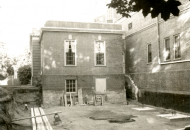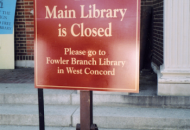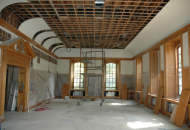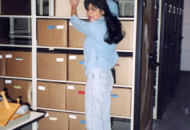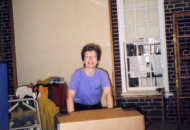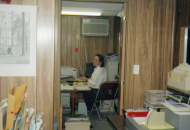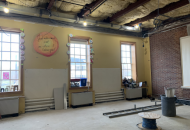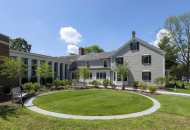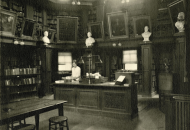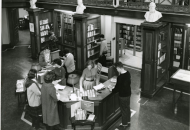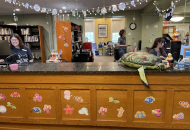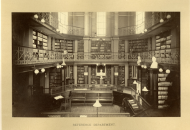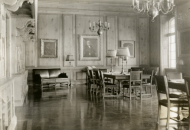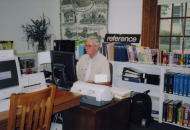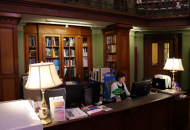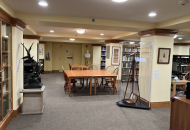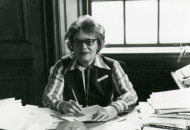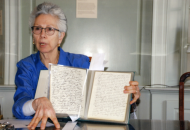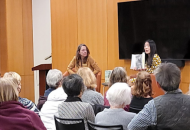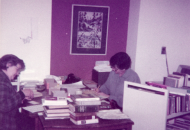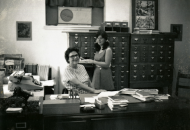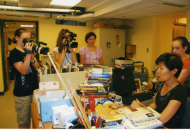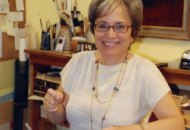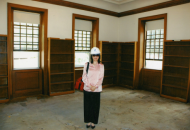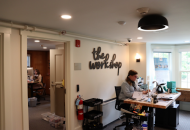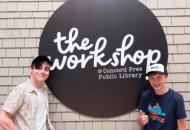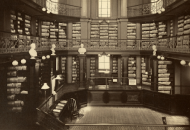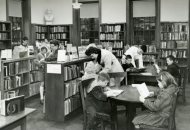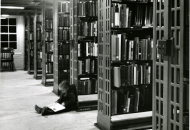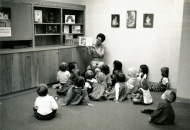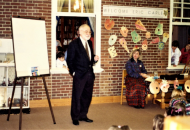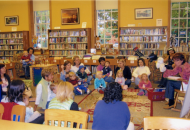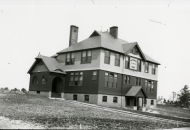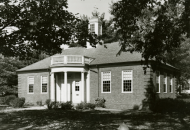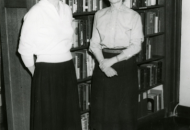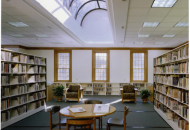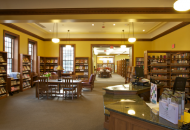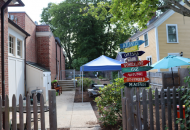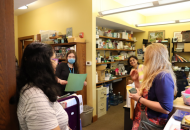

Circulation
What started out as the primary duty for the Librarian has become the largest department in the Library. From keeping track of what is on the shelves to who is checking out the material, the Circulation staff has to be detail-oriented in their management of the collection. In addition, they conduct promotional work to highlight new books and staff favorites. Circulation has been a critical operation of the Library since it opened, but only became a stand-alone department with a supervisor in 1973.
Circulation statistics are the most tangible measure of library use, but in relation to library services they must always be thought of as a pebble thrown into a pool of water. They create extensive ripples: more books to check out and check in, to shelve, to mend, to send overdue reminders and bills for, more reserves to process, more borrowers to register and provide with reference services. The custodians always know when library use goes up because of cleaning and discipline demands placed upon them. - 1978 Library Report
 As the primary point of contact with the public, the Circulation staff, with a smile and good humor, are instrumental in maintaining the availability of materials in the collection to the community. During the Covid-19 pandemic, they provided particularly exceptional service with a curbside delivery program. From July of 2020 through May 2021, staff fulfilled over 24,000 hold requests and provided over 144,000 interlibrary loans.
As the primary point of contact with the public, the Circulation staff, with a smile and good humor, are instrumental in maintaining the availability of materials in the collection to the community. During the Covid-19 pandemic, they provided particularly exceptional service with a curbside delivery program. From July of 2020 through May 2021, staff fulfilled over 24,000 hold requests and provided over 144,000 interlibrary loans.
 Reference
Reference
From the beginning, the Library’s Reference Department was ”much visited...there difficult problems are solved.” With only one staff member until 1896, the Librarian had to handle all questions, directing patrons to the Reference area, where they could look at material in magazines, encyclopedias, and other resources to answer their inquiries.
 Due to the Library’s location, the Reference Department handled extra requests from students at both the public schools on Stow Street and Concord Academy on Main Street. Following the remodel of 1933, a dedicated Reference Room was created in what is now the Trustees’ Room.
Due to the Library’s location, the Reference Department handled extra requests from students at both the public schools on Stow Street and Concord Academy on Main Street. Following the remodel of 1933, a dedicated Reference Room was created in what is now the Trustees’ Room.
Reference became its own department in 1957, with the appointment of Dorothy Israel as Head of Reference. The current reference desk was placed in its current location in 1974, with a desk created from the old circulation desk. By 1985, there was often a line of people waiting to ask questions.

 By 1994, the Reference staff was immersed in learning the Internet. They shared their newly acquired skills with patrons by teaching small classes on online resources. Today, Reference staff also helps to manage the collections through book selection and maintaining usage statistics on online databases. Reference staff provides service through many different methods, including phone, email, and in person. In addition, the staff helps coordinate a wide variety of adult programs including book clubs, author talks, and virtual poetry sessions.
By 1994, the Reference staff was immersed in learning the Internet. They shared their newly acquired skills with patrons by teaching small classes on online resources. Today, Reference staff also helps to manage the collections through book selection and maintaining usage statistics on online databases. Reference staff provides service through many different methods, including phone, email, and in person. In addition, the staff helps coordinate a wide variety of adult programs including book clubs, author talks, and virtual poetry sessions.
Special Collections

 During the first decades following the establishment of the Concord Free Public Library, the collections increased dramatically through the generosity of many donors. The Library’s annual reports for the years immediately following the Library dedication document impressive donations of books, pamphlets, periodicals, manuscripts, personal and family papers, organizational records, paintings, sculptures, and even coins. These early donations began what would develop into the Concord Free Public Library's William Munroe Special Collections.
During the first decades following the establishment of the Concord Free Public Library, the collections increased dramatically through the generosity of many donors. The Library’s annual reports for the years immediately following the Library dedication document impressive donations of books, pamphlets, periodicals, manuscripts, personal and family papers, organizational records, paintings, sculptures, and even coins. These early donations began what would develop into the Concord Free Public Library's William Munroe Special Collections.

Requests to use the material were primarily handled by the Reference Department, with a staff member managing the Special Collections area. However, working with researchers became more pressing with the Bicentennial of the Concord Fight in 1975. Special Collections was first called a department in 1975, and the head of Reference, Marcia Everson Moss, was named the first Curator of Special Collections in 1977. Joyce Woodman was hired in 1978 as the Special Collections Assistant. A permanent home for Special Collections was created upon the agreement in the mid-1980s between the Town of Concord and the Corporation to fund a vault to house both the Town's historical records and the Special Collections materials. The vault and the Special Collections reading room were opened to the public in 1991.
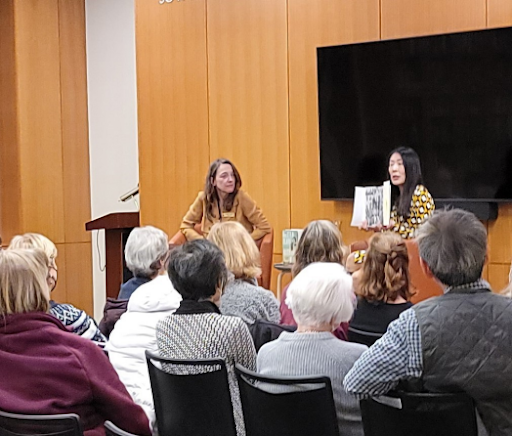 The Concord Free Public Library Corporation owns the William Munroe Special Collections. The mission of Special Collections is to provide an understanding and appreciation of Concord's history and culture through developing, preserving, interpreting, sharing, and promoting the Collections. A primary purpose of Special Collections is to maintain its holdings for use by the public. This includes a wide range of researchers at all levels, including local residents, students, businesses, organizations, and producers of documentary films. Special Collections also provides unique programming to highlight the collections through lectures, articles, and exhibitions.
The Concord Free Public Library Corporation owns the William Munroe Special Collections. The mission of Special Collections is to provide an understanding and appreciation of Concord's history and culture through developing, preserving, interpreting, sharing, and promoting the Collections. A primary purpose of Special Collections is to maintain its holdings for use by the public. This includes a wide range of researchers at all levels, including local residents, students, businesses, organizations, and producers of documentary films. Special Collections also provides unique programming to highlight the collections through lectures, articles, and exhibitions.
Technical Services

Technical Services maintains the Library's computer workstations as well as all the activities that surround the addition and withdrawal of books, periodicals, audiovisual materials, and digital items. Technical Services also houses the conservation studio where books are repaired by a trained conservator. While cataloging, accession, and selection of the books in the Library has always been a part of staff duties, the first full-time cataloger was not added to the staff until 1944. In 1965, all activities related to putting books on the shelves were done on-site by the Technical Services staff after previously outsourcing the acquisitioning, cataloging, and processing to the Alanar Processing Center in Pennsylvania.
Technical Services staff maintained two card catalogs—a subject index and one for authors and titles. In 1982, they began to do a full inventory of all Library materials in preparation for the Library’s integration with Minuteman Library Network. It would take three full years to barcode the entire collection. While the Library went online with Minuteman in 1986, staff continued cataloging older books and maintaining the card catalog until 1990. Today, Technical Services helps to maintain the website, all technology within the Library, and the full scope of processing new books that arrive on the shelves.





The Workshop
As various proposals for the use of the Heywood-Benjamin House arose upon the Trustees’ purchase in 2013, one of the earliest requests was for a creative space for Concord residents. A makerspace with collaborative areas, access to equipment, and time to learn new skills was deemed essential to the vision for the Library’s future.
As various plans for the space evolved, eventually, the first floor of what is now known as the Library House would be primarily used for makerspace activities. Equipment was ordered, and a Makerspace Coordinator, Christiana Urbano, was hired. The opening of the Workshop was the final piece of the most recent renovation, with its grand opening on June 10, 2023. The Eagle Room in the Workshop hosts 3-D printers as well as a large collaborative space for classes and projects. The Workshop is a collaborative work place with tools and equipment designed to help the community explore, learn, and make together. The Workshop is an all-ages makerspace designed to encourage intergenerational learning, and classes and events cater to a wide range of ages and abilities.
The Workshop has a wide array of tools, from knitting needles, embroidery hoops, and crochet hooks, to 3-D printers and laser cutters. These tools can be used during the Open Maker hours each week, and special classes are available each month. Recent classes included soap making, glass etching, laser-cut jewelry, and a regular knitters’ workshop. The Workshop also hosts Sustainable Makes which focuses on environmentally friendly DIY projects.




Youth Services
Children's
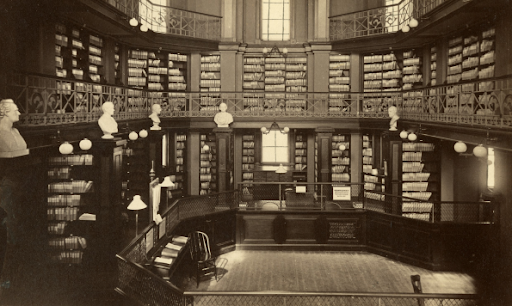 In 1873, when the Library opened, the rules for usage made no mention of children. Books for juveniles were integrated into the collection and, along with fiction, made up a sizable majority of the Library’s circulation. Area students used the Library regularly. However, there was no place children could gather away from the adults.
In 1873, when the Library opened, the rules for usage made no mention of children. Books for juveniles were integrated into the collection and, along with fiction, made up a sizable majority of the Library’s circulation. Area students used the Library regularly. However, there was no place children could gather away from the adults.
 Calls for a dedicated children’s room began in 1909 to “relieve the reading room for the adults from the presence of the young people.” When the 1917 stack wing addition opened, children’s books were available behind the delivery desk and children could read at the tables in the alcove. By 1924, the Library report noted that “our buildings are much used by the school children at all hours, even at recess.”
Calls for a dedicated children’s room began in 1909 to “relieve the reading room for the adults from the presence of the young people.” When the 1917 stack wing addition opened, children’s books were available behind the delivery desk and children could read at the tables in the alcove. By 1924, the Library report noted that “our buildings are much used by the school children at all hours, even at recess.”

The Children’s Room opened in 1933 following the renovation. Many of the Library’s expansions have come from the need for more space for children and their collections. In 1968, the Children’s Department moved into its new space where the old stacks used to be, with the old Children’s Room becoming the Thoreau Room. Following the move, sixty percent of all Library circulation came from the Children’s Department.
Following the expansion of 1968, children’s programming expanded. Six story times for preschoolers happened weekly, and elementary school-age story time occurring once a month. Children’s reading continued at a high rate, with the 1978 Library Report stating that “for many children, the experience is a personal one, as they tell the librarians what they want or ask their advice on a good book.”
Children’s staff has always worked to be more accommodating to all of the young users. In 1976, new services were added for hearing impaired children. In 2002, the Library received an assistive technology grant that added adjustable tables and screen enlarging software.
Additional programs began including authors and illustrators of children’s books, with many coming from the Concord area. Talented local artists like Kristina Joyce would give regular workshops for children on a variety of artistic methods. Book discussion groups for 4th and 5th graders as well as for young adults were started. Today, teens and children are served by the Youth Services Department. The Concord Free Public Library welcomes children of all ages and strives to create a welcoming, fun, and safe environment for children to develop a love of books, reading, and libraries.
Teen Lounge
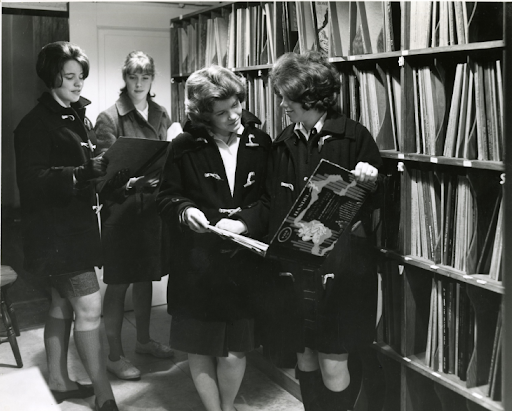 Young adults have always utilized the Library extensively. When the high school was just across Sudbury Road, the students would come over immediately after school ended for the day. Yet there was no place designated just for them in the building. Children’s got their own room in 1933, but young adults were caught in the middle. In 1955, Library director Fred Bloomhardt wrote in the annual report that “there needs to be a separate room...for the high school students...with its own collections...and its own Young People’s Librarian ‘who can talk their own language and yell just as loud.'
Young adults have always utilized the Library extensively. When the high school was just across Sudbury Road, the students would come over immediately after school ended for the day. Yet there was no place designated just for them in the building. Children’s got their own room in 1933, but young adults were caught in the middle. In 1955, Library director Fred Bloomhardt wrote in the annual report that “there needs to be a separate room...for the high school students...with its own collections...and its own Young People’s Librarian ‘who can talk their own language and yell just as loud.'
In the 1968 expansion, the original plan was that the previous Children’s Room (now the Thoreau Room) would serve as a haven for young adults. Instead, the room became a place for books on the fine, performing, and applied arts as well as the record collection. While a book collection for young adults was begun in 1968, as well as purchasing more rock and popular music records, the teens still had no space to call their own. The teen volunteer program was thriving in the early 1970s, including planning the annual summer program “Sunthing.” However, no room would be carved out for them until 2005, when the current large print area was made into a Teen Lounge.
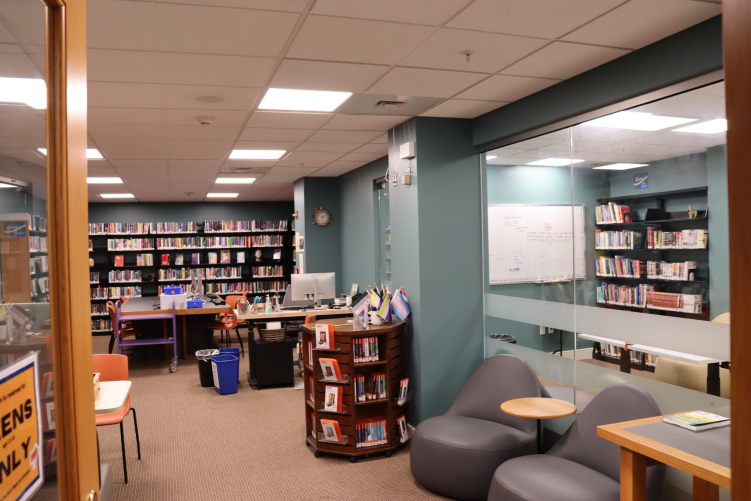
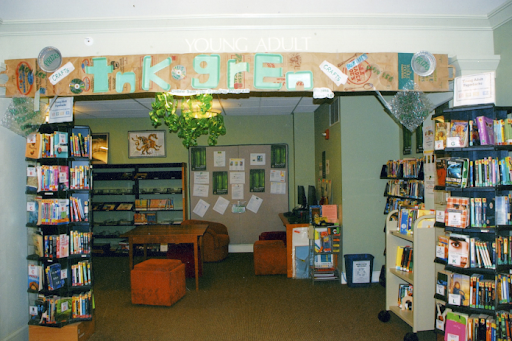
More programming began for teens and tweens after the new space was created. In 2008, special finals study hours on Sundays were established. A Teen Advisory Board started advising the Library on programs and materials in 2013. In 2018, the first librarian with duties specific to young adults, Olivia Durant, was hired, bringing new programs, a newsletter, and updated collections. During discussions on the most recent renovation, a new lounge with doors as well as a full-time teen librarian were deemed must haves. So, in April of 2022, the Teen Lounge was opened along with the hiring of Teen Librarian Cary Stough. It has quickly become one of the busiest places in the Library!

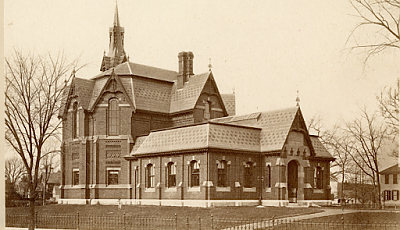
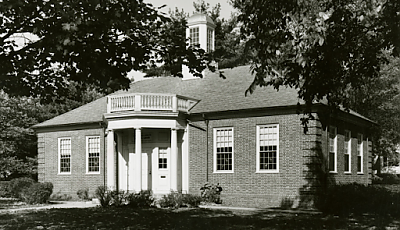
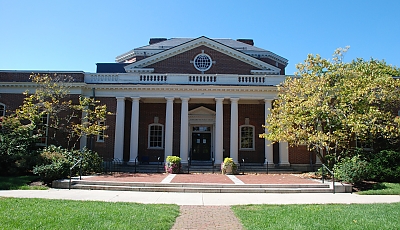
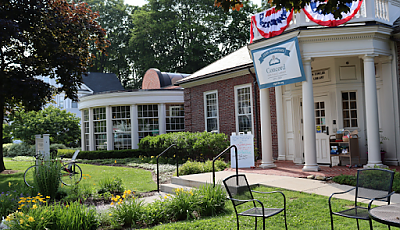




 Whitney had a monumental task ahead of her. The Town Library, which was transferred to the new Concord Free Public Library, contained nearly 7,000 items. In addition, the Library Committee was actively soliciting additional donations from the community. By the time the Library opened on October 1, 1873, the new Library contained over 10,000 items. As part of her duties, Whitney had to create an accession catalogue with the titles and authors of each work as well as how it was acquired. Before opening, Whitney had to “cleanly cover” each title and carefully label and arrange each book according to the rules set forth by the Corporation. She created a card catalog and shelf list and maintained a record of all books loaned and returned.
Whitney had a monumental task ahead of her. The Town Library, which was transferred to the new Concord Free Public Library, contained nearly 7,000 items. In addition, the Library Committee was actively soliciting additional donations from the community. By the time the Library opened on October 1, 1873, the new Library contained over 10,000 items. As part of her duties, Whitney had to create an accession catalogue with the titles and authors of each work as well as how it was acquired. Before opening, Whitney had to “cleanly cover” each title and carefully label and arrange each book according to the rules set forth by the Corporation. She created a card catalog and shelf list and maintained a record of all books loaned and returned.  Ellen Whitney did all of these duties plus many more on her own for over twenty years. In 1878, the Library Committee recognized that the rapid rate of growth in the Library had “made the labors of the Librarian very burdensome” suggesting the need to hire an assistant in the near future. However, Whitney’s “remarkable efficiency” pushed that date until 1896.
Ellen Whitney did all of these duties plus many more on her own for over twenty years. In 1878, the Library Committee recognized that the rapid rate of growth in the Library had “made the labors of the Librarian very burdensome” suggesting the need to hire an assistant in the near future. However, Whitney’s “remarkable efficiency” pushed that date until 1896. 
 When the Library first opened in 1873, regulations and a fence kept patrons from accessing the shelves to peruse books. Only the Librarian was allowed to take and replace books from the shelves. In 1909, Trustee George A. King said “The Library cannot be made of its utmost value until the people are brought into contact with the books and are enabled to select from the shelves such a volume as responds to their needs and wishes.” When the stack addition was built in 1919, the fence was removed, allowing patrons access to the shelves and stacks for the first time. The stack addition would remain until the renovation of 1968.
When the Library first opened in 1873, regulations and a fence kept patrons from accessing the shelves to peruse books. Only the Librarian was allowed to take and replace books from the shelves. In 1909, Trustee George A. King said “The Library cannot be made of its utmost value until the people are brought into contact with the books and are enabled to select from the shelves such a volume as responds to their needs and wishes.” When the stack addition was built in 1919, the fence was removed, allowing patrons access to the shelves and stacks for the first time. The stack addition would remain until the renovation of 1968. 





















 As the primary point of contact with the public, the Circulation staff, with a smile and good humor, are instrumental in maintaining the availability of materials in the collection to the community. During the Covid-19 pandemic, they provided particularly exceptional service with a curbside delivery program. From July of 2020 through May 2021, staff fulfilled over 24,000 hold requests and provided over 144,000 interlibrary loans.
As the primary point of contact with the public, the Circulation staff, with a smile and good humor, are instrumental in maintaining the availability of materials in the collection to the community. During the Covid-19 pandemic, they provided particularly exceptional service with a curbside delivery program. From July of 2020 through May 2021, staff fulfilled over 24,000 hold requests and provided over 144,000 interlibrary loans. Reference
Reference Due to the Library’s location, the Reference Department handled extra requests from students at both the public schools on Stow Street and Concord Academy on Main Street. Following the remodel of 1933, a dedicated Reference Room was created in what is now the Trustees’ Room.
Due to the Library’s location, the Reference Department handled extra requests from students at both the public schools on Stow Street and Concord Academy on Main Street. Following the remodel of 1933, a dedicated Reference Room was created in what is now the Trustees’ Room.
 By 1994, the Reference staff was immersed in learning the Internet. They shared their newly acquired skills with patrons by teaching small classes on online resources. Today, Reference staff also helps to manage the collections through book selection and maintaining usage statistics on online databases. Reference staff provides service through many different methods, including phone, email, and in person. In addition, the staff helps coordinate a wide variety of adult programs including book clubs, author talks, and virtual poetry sessions.
By 1994, the Reference staff was immersed in learning the Internet. They shared their newly acquired skills with patrons by teaching small classes on online resources. Today, Reference staff also helps to manage the collections through book selection and maintaining usage statistics on online databases. Reference staff provides service through many different methods, including phone, email, and in person. In addition, the staff helps coordinate a wide variety of adult programs including book clubs, author talks, and virtual poetry sessions.
 During the first decades following the establishment of the Concord Free Public Library, the collections increased dramatically through the generosity of many donors. The Library’s annual reports for the years immediately following the Library dedication document impressive donations of books, pamphlets, periodicals, manuscripts, personal and family papers, organizational records, paintings, sculptures, and even coins. These early donations began what would develop into the Concord Free Public Library's William Munroe Special Collections.
During the first decades following the establishment of the Concord Free Public Library, the collections increased dramatically through the generosity of many donors. The Library’s annual reports for the years immediately following the Library dedication document impressive donations of books, pamphlets, periodicals, manuscripts, personal and family papers, organizational records, paintings, sculptures, and even coins. These early donations began what would develop into the Concord Free Public Library's William Munroe Special Collections.
 The Concord Free Public Library Corporation owns the William Munroe Special Collections. The mission of Special Collections is to provide an understanding and appreciation of Concord's history and culture through developing, preserving, interpreting, sharing, and promoting the Collections. A primary purpose of Special Collections is to maintain its holdings for use by the public. This includes a wide range of researchers at all levels, including local residents, students, businesses, organizations, and producers of documentary films. Special Collections also provides unique programming to highlight the collections through lectures, articles, and exhibitions.
The Concord Free Public Library Corporation owns the William Munroe Special Collections. The mission of Special Collections is to provide an understanding and appreciation of Concord's history and culture through developing, preserving, interpreting, sharing, and promoting the Collections. A primary purpose of Special Collections is to maintain its holdings for use by the public. This includes a wide range of researchers at all levels, including local residents, students, businesses, organizations, and producers of documentary films. Special Collections also provides unique programming to highlight the collections through lectures, articles, and exhibitions.









 In 1873, when the Library opened, the rules for usage made no mention of children. Books for juveniles were integrated into the collection and, along with fiction, made up a sizable majority of the Library’s circulation. Area students used the Library regularly. However, there was no place children could gather away from the adults.
In 1873, when the Library opened, the rules for usage made no mention of children. Books for juveniles were integrated into the collection and, along with fiction, made up a sizable majority of the Library’s circulation. Area students used the Library regularly. However, there was no place children could gather away from the adults. Calls for a dedicated children’s room began in 1909 to “relieve the reading room for the adults from the presence of the young people.” When the 1917 stack wing addition opened, children’s books were available behind the delivery desk and children could read at the tables in the alcove. By 1924, the Library report noted that “our buildings are much used by the school children at all hours, even at recess.”
Calls for a dedicated children’s room began in 1909 to “relieve the reading room for the adults from the presence of the young people.” When the 1917 stack wing addition opened, children’s books were available behind the delivery desk and children could read at the tables in the alcove. By 1924, the Library report noted that “our buildings are much used by the school children at all hours, even at recess.”
 Young adults have always utilized the Library extensively. When the high school was just across Sudbury Road, the students would come over immediately after school ended for the day. Yet there was no place designated just for them in the building. Children’s got their own room in 1933, but young adults were caught in the middle. In 1955, Library director Fred Bloomhardt wrote in the annual report that “there needs to be a separate room...for the high school students...with its own collections...and its own Young People’s Librarian ‘who can talk their own language and yell just as loud.'
Young adults have always utilized the Library extensively. When the high school was just across Sudbury Road, the students would come over immediately after school ended for the day. Yet there was no place designated just for them in the building. Children’s got their own room in 1933, but young adults were caught in the middle. In 1955, Library director Fred Bloomhardt wrote in the annual report that “there needs to be a separate room...for the high school students...with its own collections...and its own Young People’s Librarian ‘who can talk their own language and yell just as loud.'








